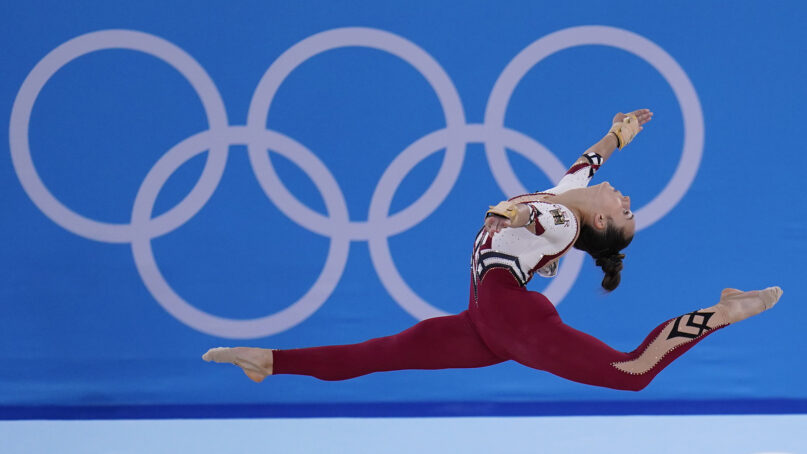(RNS) — There’s a revolution underway among female athletes who are fighting back against the gender imbalance embedded in sports uniforms. But the battle must expand beyond the sports arena to fulfill its full feminist promise.
The German women’s Olympic gymnastics team wore unitards in their recent qualification event, instead of leotards. Days earlier, the Norwegian women’s beach handball team was fined for wearing shorts instead of the required bikini bottoms.
The imbalanced uniform requirements are set out in great detail in the official rules for these sports. For female gymnasts: “The leotard leg length cannot exceed the horizontal line around the leg, delineated by no more than 2 cm below the base of the buttocks.” Male gymnasts, in contrast, “must wear long solid colored competition pants and footwear.” In some instances, they can wear shorts.
The discrepancies are just as shocking in beach handball. Women must wear “midriff” baring tops with “deep cutaway armholes on the back” and “bikini bottoms” that are “cut on an upward angle toward the top of the leg,” with a “side width” of a “maximum of 10 centimetres.” Men’s tops, in contrast, are standard “sleeveless” T-shirts, and they “must wear shorts” that can be as long as “10 centimetres above the kneecap.”
Why do sports’ team guidelines have such disparate standards for male and female athletes? Perhaps because Western society has developed a skewed understanding of what female modesty means. When the PGA attempted to add more conservative standards to the women’s uniform in 2017, in order to more closely match the men’s, they were met with accusations of body-shaming, with one online commenter comparing them to ISIS.
Sadly, the notion of women covering up has become associated with subjugation when, in fact, many religious women, from Orthodox Jews to Muslims to conservative Christians, find it to be a form of liberation.
In contrast, the “skin gap” — the difference in the amount of skin men and women are expected to show in the same social setting in contemporary Western culture — is its own form of subjugation. From gymnasts to volleyball players, actors to news anchors, we are constantly fed images of girls and women in less clothing than boys and men, hypersexualizing women’s bodies and normalizing the notion that female body parts are meant for consumption.
It’s the woman in a strapless, low-cut gown next to the man in a tuxedo. It’s the teenager in a crop-top and short shorts with her boyfriend in cargo shorts and polo shirt. The fashion industry designs and aggressively markets clothing choices for women with less fabric than clothing for men.
The skin gap, a term I coined, begins in toddlerhood. Stephanie Giese wrote about this discrepancy, comparing size 4T Cherokee shorts for girls versus boys. While the inseam on the girls’ short was only 1 inch long, the same brand offered boys an inseam almost seven times longer.
The skin gap continues as long as a woman meets the Western beauty standard. Then, once she exceeds a certain number in either age or pounds, we prefer that she cover up. “Older actresses do nude scenes too,” one man told me, attempting to disprove my theory, “like Helen Mirren,” at which point he indicated his revulsion, thus destroying his rebuttal.
While forced modesty certainly oppresses women, the pressure to uncover does exactly the same thing. Empowered modest religious women have known for years there is an incredible autonomy in getting to decide who and in what contexts others see our bodies.
In Hebrew, the word for modesty, “tzniut,” means “privacy.” Tzniut is not about shame or control. It’s about recognizing that covering a body allows talents, personality and skills to shine through. We would never want to revert to a time when females were forced to cover up. But as women gain equal status to men in nearly every other sphere, the pressure for us to expose ourselves more than men is one of the things holding us back.
Women shouldn’t cover due to shame or social pressure, but, as men do, to simply remove our bodies from being a central focus, so we are considered more as beings and less as bodies. There are some who will say women can freely choose what to wear (though not, it seems, at the Olympics). But how can one truly be free in a society where one is barraged with constant media messaging?
Brave women like those on the Norwegian handball team and the German gymnasts can lead the way so the Western world can begin to change the inequality in expectations inherent in the skin gap. We need to put an end to the objectification of girls and women and build a world where females are judged not by the hotness of their bodies but by their skills, their talents and the content of their characters.
(Allison Josephs is the founder and director of Jew in the City, a nonprofit that shows the relevance and meaning in Orthodox Judaism. The views expressed in this commentary do not necessarily reflect those of Religion News Service.)





